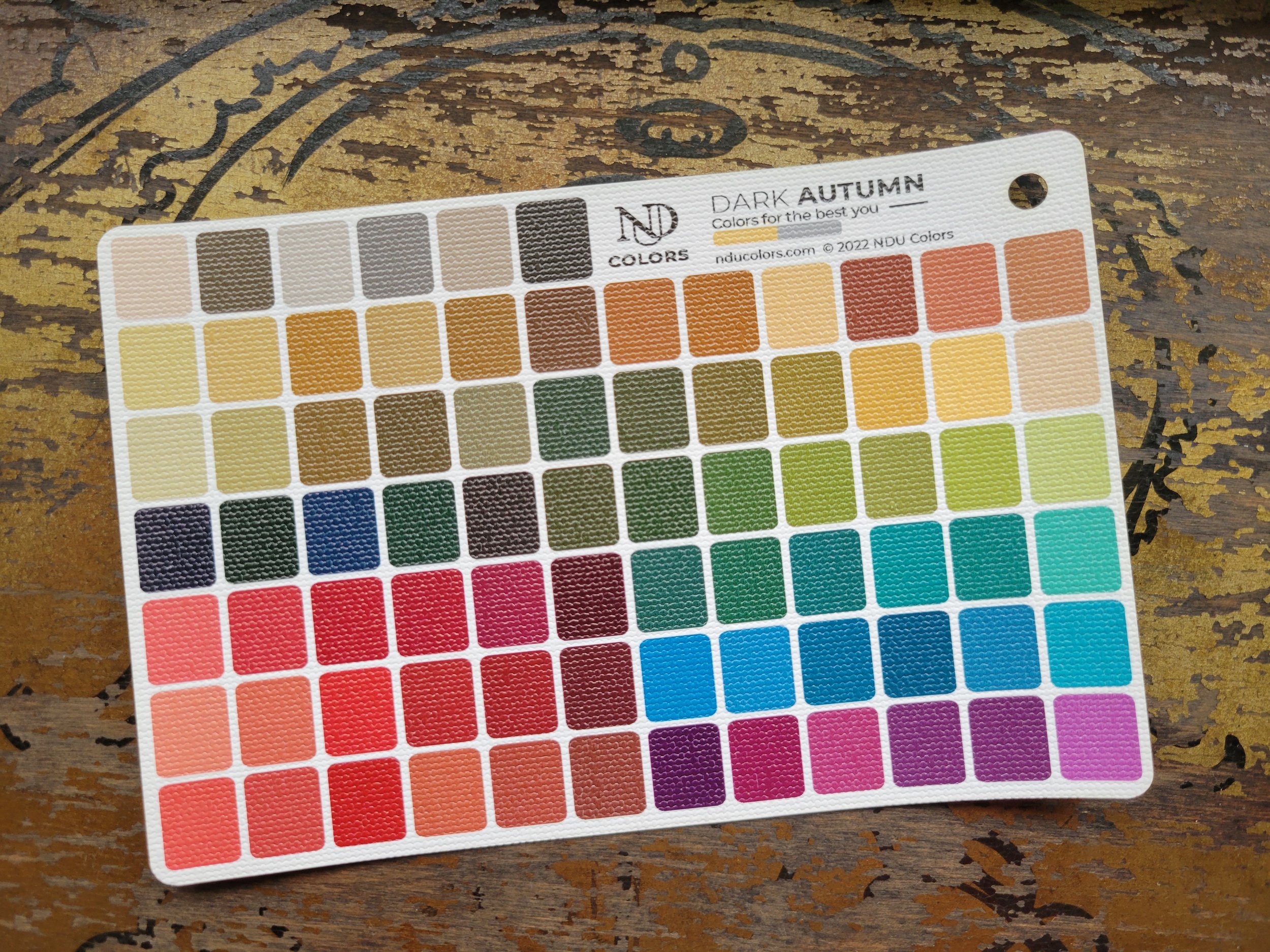First, let’s explore their technical parameters:
The True seasons are the “primary colors” of PCA. While the seasons exist on a spectrum, the True seasons combine in different ways to form the Neutral seasons (Lights, Brights, Softs, and Darks).
True Autumn is one of the two true warm seasons. The colors are rich and rustic, bringing to mind spice markets and fallen leaves. True Autumn colors are more matte or “dry” in appearance than the juicy shades of the other true warm season, True Spring. They are also darker and more muted.
Dark Autumn is a Warm-Neutral season. Dark Autumn takes its base from True Autumn, with a dash of True Winter’s electric coolness. Dark Autumn’s colors are are still obviously autumnal, but their darkness and winter influence lends them an intense and burnished glow.
Summer pastels and spring brights are not a friend to either of these seasons. They can look chalky, dusty, childish, or ungrounded on the autumn face and body. Likewise, the icy sharpness of winter can look hard and severe.
Aside from temperature, one difference between these two seasons is that the Dark Autumn palette is slightly higher in contrast than True Autumn, with more distance between the lightest and coolest colors in the palette.
What happens when a True Autumn wears Dark Autumn colors?
A True Autumn wearing full-on Dark Autumn colors, particularly in makeup, may find her skin looking more pale, blue, or gray than it really is. Dark Autumn’s increased coolness can be harsh on the warmer True Autumn, manifesting in darker under-eye circles, or drier-looking skin. Eye color can look slightly faded. A True Autumn wearing Dark Autumn may find that she looks more severe or tired than her baseline.
What happens when a Dark Autumn wears True Autumn colors?
A Dark Autumn wearing full-on True Autumn clothing or makeup may find that her skin looks more sallow or orange than it really is. Eye makeup that’s too warm can make the eyes look red or watery, even ill, and lipstick that’s too warm can read as distinctly orange. A Dark Autumn wearing True Autumn may find that she looks slightly dusty or out of focus, not as vibrant as her baseline.
How do these two autumns wear their makeup?
All three autumn seasons are flattered by both matte and metallic effects, to varying degrees. Autumns will want to avoid overly-dewy looks, but makeup doesn’t have to be the mattest of matte across the entire face to be effective. Satin lipsticks and cream finishes are perfectly fine, though autumns will usually want to avoid heavily lacquered or vinyl-like textures, which can look slippery, formless, or even greasy on the autumn face. Where autumns really shine is in contrast of textures and light - such as a matte skin finish paired with a metallic eyeshadow or gleaming bronzer.
True Autumn is flattered by warm, medium-contrast makeup. Eye makeup is easy for this season, where palettes and singles in seasonally-appropriate colors abound. Take a look at Too Faced Natural Eyes or MAC Brule, Cork, and Wooodwinked. Eyeliners can be brown or bronze, like Clinique Roast Coffee or Hourglass Bronze, or even a lustered green like Urban Decay Stash. For cheeks, look for shades of rosy bronze, like Lancôme Shimmer Mocha Havana or NARS Lovejoy. For a more vibrant coral red, try 12 Blueprints Tiger Lily. For lipstick, you’ll find words like carnelian, chili, and cinnamon. Try Moira Beauty Drop the Beat, Merit Cara Cara, Glossier Trench, and MAC Brick O La.
Dark Autumn is flattered by warm, medium-contrast makeup, but it will veer cooler and darker than True Autumn. An individual Dark Autumn can still go too dark for comfort in makeup, so make sure you’re assessing all cosmetics within the context of your individual coloring. Like True Autumn, the world is your oyster when it comes to eyeshadow. Take a look at Maybelline Chai Latte, or the Natasha Denona Mini Nude palette. For singles, try Anastasia Beverly Hills in Vermeer, Warm Taupe, and Glisten. For eyeliner, metallics can be great, like Stila Lionfish and Urban Decay Stash, or a simple matte brown like Revlon Brown. For cheeks, look for scorched coral and warm burgundy, like NARS Taos, Moira Beauty I Need You, or Maybelline Deep Wine. For lipsticks, try Clarins Spicy Cinnamon, Bobbi Brown Cassis, and Revlon Wine With Everything (cream version).
Can these two seasons “cheat” with some of the same colors?
Honestly, yes. I find that all three autumns can borrow from their nearest autumn neighbor fairly successfully, depending on the individual and the colors in question. In particular, olive and brown shades tend to be very forgiving across all three autumns. But as always, be careful that you aren’t buying other seasons’ colors so much that you’re accidentally creating a seasonally-fractured wardrobe. Clothing for all three autumns is easy to find, so you should be able to build a seasonally-cohesive wardrobe without much fuss.
In makeup, these seasons share many eyeshadow and eyeliner colors well, as well as some bronzers and blushes. Lipstick colors have perhaps the least crossover, though there are exceptions, like Clinique Chunkiest Chili.
One last thing to note about these two seasons is that they can both wear brighter colors than one might expect. Autumn is muted, but autumn is also rich, like golden hour - not faded or powdery. Even Soft Autumn, the most muted autumn, is rich and vibrant in its own right.
If you’d like to explore these two seasons further, check out my Pinterest boards:




